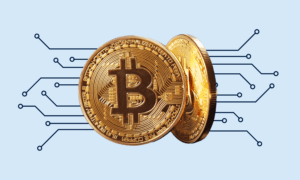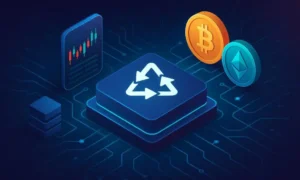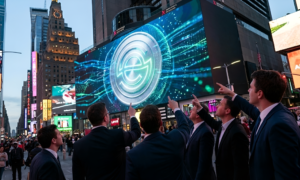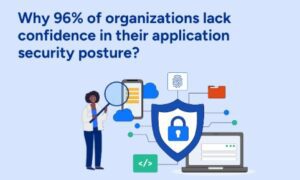TechBullion spoke with Patrick Moynihan, the Founder and CEO of Epic Funds, about Epicenter and its mission to bridge the gap between digital currencies and traditional finance.
Patrick explained that Epicenter is an open-source, decentralized finance (DeFi) ecosystem that includes lending, staking, swapping and payments, with on and off rails to fiat, precious metals and the equity markets. The ecosystem provides a monetary framework for decentralized finance, allowing globally accessible financial services to be created and platformed in a matter of minutes. The Epicenter goal is to dramatically lower the barriers to entry for both producers and consumers of such services.
The ecosystem rests on a foundation of three interlocked, composable components: Epic Cash, the EUSD stablecoin and the ECR token:
- Epic Cash is a blockchain-based store of value, designed to be private, lightweight, fast and efficient.
- The EUSD token is soft-pegged to the US dollar: one EUSD is always redeemable for $1 worth of Epic Cash.
- ECR is the governance token for the system; through voting rights, ECR holders tune the system parameters so as to maintain the EUSD soft peg.
EUSD tokens can circulate on 32 different smart-contract blockchains, including Ethereum, Polkadot, Binance Smart Chain, Tron, Avalanche, Solana and many more.
Launched in September 2019 under the ticker symbol EPIC, Epic Cash is a novel, Rust-based implementation of the original Bitcoin Standard, updated with modern technologies to improve scalability, accessibility, censorship resistance, centralization resistance, fungibility and regulatory compliance. It uses the Mimblewimble protocol to drastically reduce the blockchain size, together with the CoinJoin and Confidential Transactions technologies to enforce transaction privacy. By using multiple algorithms for proof of work, EPIC can be mined on home computers or even, soon, smartphones. Like Bitcoin, EPIC has a 21 million coin hard cap on total supply, with 11 million coins having already been mined. EPIC supply will catch up to BTC supply by May 2028, and then stay in sync with Bitcoin supply from that point forward.
Patrick spoke about the Epicenter project and what he expects to see in the world of DeFi in 2021.
What can you tell us about the Epicenter project and who makes up the team?
I first ran across a draft of the EPIC/EUSD whitepaper on Bitcointalk in December 2018. The project is fairly unique in that there is no actual team, just a collection of independent volunteers. The volunteer contributors often use “Freeman” as a pseudonym for their family name, as a sort of tribute to their Libertarian forebears. Epicenter takes great pride in being community driven. There are dozens of social media groups on Telegram, Facebook, Wechat and other sites, dealing with various topics on which the contributors are coordinating. I probably engage with a few hundred Freemen on a daily basis. Right now there are about 4k miners around the world and that number is growing rapidly.
How does EPIC compare with Bitcoin?
EPIC has more in common with Nakamoto’s original vision for Bitcoin, rather than what Bitcoin has evolved into. Nakamoto envisioned p2p electronic cash, a true medium of exchange, not simply a replacement for gold. Focusing solely on a cryptocurrency as a store-of-value is unnecessarily limiting, and fails to take advantage of the real strengths of this tremendously powerful paradigm. If your Bitcoin can be censored or confiscated, costs $28 for a 10 minute transfer and is vulnerable to shifting political winds and regulations, then it is far from what Satoshi had in mind. Bitcoin was supposed to be censorship resistant but today you have AI-driven transaction blacklisting. Centralized intermediaries need to filter at both the mining pool and exchange levels in order to protect themselves from tainted coins.
Epic Cash coins cannot become tainted because their transaction graph is not stored on the chain: in every block the coins are melted down and minted fresh. In all the ways that matter, Epic is more Bitcoin than Bitcoin itself, which is increasingly centralized, censorable, permissioned and subject to confiscation.
The Epicenter project has stated an ambitious goal, to make crypto usable for everyday transactions. Can you tell us how you intend to meet that goal?
The mission is to bring true, p2p electronic cash to the 1.7 billion people around the globe who currently lack any access whatsoever to the modern global financial system. The EPIC blockchain is ideal for this population because it is so efficient and lightweight, with a full node requiring only 1.2 Gb. Using any modern smartphone, ordinary people with no special skills can independently verify the full state of the chain and earn income through mining.
The ecosystem is quite vibrant, with entrepreneurs building startups that leverage the unique capabilities of the chain to add value to their clients’ lives immediately. It is not monolithic; it is more like a fleet of independent ships that maneuver together.
Legacy blockchains expose their users to the risk of tainted coins and allow businesses real-time insight into their competitors’ most sensitive financial data. With EPIC, the twin pillars of fungibility and basic commercial confidentiality are a powerful combination that will solve currently intractable problems and open up new use cases.
The final piece of the puzzle is interoperability. EUSD connects independent blockchains together using EPIC as a universal fungibility layer. The commercial team has laid out a plan to connect EPIC/EUSD to fiat, gold, and the public equity markets. I have seen their resumes and these guys have the background and experience to make it happen.
What about regulatory compliance?
As a fiduciary, I need to know that the digital assets I recommend for my clients are on solid ground with respect to regulatory compliance, both now and in the future. There are tons of great networks out there, but many of them are at risk of having their assets designated as securities. All Epicenter protocols are community fair launched without any centralized entity anywhere in the picture – no ICO, no premine. Even under the most aggressive legal interpretation, these assets are not securities.
This is extremely important for preserving censorship resistance, which is one of the essential properties of a true cryptocurrency, as opposed to a project that is only decentralized “to some degree”.
XRP is currently the target of an SEC lawsuit, despite having spent $10m on lobbying. Epicenter assets are not subject to this risk as there is no reliance on centralized intermediaries. EPIC was designed for decentralized exchanges, where trustless, non-custodial, p2p services predominate.
What can we expect to see from EPIC and Epicenter in 2021?
On February 28th, there will be a snapshot of ownership of the Epic Cash chain, and this will be used to enable an airgrab claim process for the genesis of the ECR token. If you own 1 Epic, you can claim 1 ECR. This ECR can be freely sold immediately, or can be used for staking. Staking ECR over the course of the following 6 quarters will yield further 1:1 airgrabs of the remaining components of the Epicenter system: EMPL, EON, EDX, ECHO, and EFX. Owning Epicenter tokens is like owning a crowdsourced VC incubator that spins out free dApps as they are built.
On the commercial side, I am leading an effort to establish Epicenter Equity Corp as an investable pure play DeFi startup for equity market investors. Gold led me to crypto residing outside of credit, counter party and debasement of currency risk. There is a shortage of quality companies in this space, so we are placing the business on the fast track to become a public company for greater access. Epicenter Equity Corp focuses on the EUSD-USD and EUSD-precious metals markets, supporting the currency standard’s adoption through deep liquidity and tight spreads for people to trade. Credit card swipe fees are 2.5+%, and we can cut that in half, with no contracts, no fine print, and no special equipment required.
How do you think the DeFi industry will evolve over the course of this year and the coming years?
I think that investor patience is wearing thin with the “move fast and break things” model, with the recent draining of Alpha Homora for $37m as a cautionary tale. Finance is too important for shoddy workmanship, in a rush to market before the current hype cycle fades. Epicenter has taken a slower, more careful approach in its design and engineering, with the result that the platform is thoroughly tested, stable and robust.
Institutional investors, in particular, need to know that the designers of DeFi protocols had their needs in mind when building them. As the industry matures, its leaders must also, and this means finding a constructive common ground with regulators, public policy makers, and financial crime fighters to ensure that privacy is protected, national sovereignty is not compromised, and underserved populations are not frozen out through the unintended consequences of well-meant legislation.



































